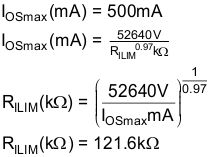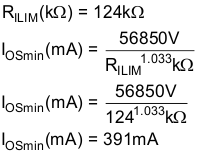JAJSEL2D January 2018 – December 2019 TPS25221
PRODUCTION DATA.
- 1 特長
- 2 アプリケーション
- 3 概要
- 4 改訂履歴
- 5 Device Comparison Table
- 6 Pin Configuration and Functions
- 7 Specifications
- 8 Parameter Measurement Information
- 9 Detailed Description
- 10Application and Implementation
- 11Power Supply Recommendations
- 12Layout
- 13デバイスおよびドキュメントのサポート
- 14メカニカル、パッケージ、および注文情報
10.2.1.2.2 Designing Below a Maximum Current Limit
Some applications require that current limiting must occur below a certain threshold. For this example, assume that the desired upper current-limit threshold must be below 500 mA to protect an up-stream power supply. Use the IOS equations and Figure 24 to select RILIM.
Equation 5. 

Select the closest 1% resistor greater than the calculated value: RILIM = 124 kΩ. This sets the maximum current-limit threshold at 500 mA . Use the IOS equations, Figure 24, and the previously calculated value for RILIM to calculate the minimum resulting current-limit threshold.
Equation 6. 

The resulting minimum current-limit threshold is 391 mA with a 124 kΩ resistor.